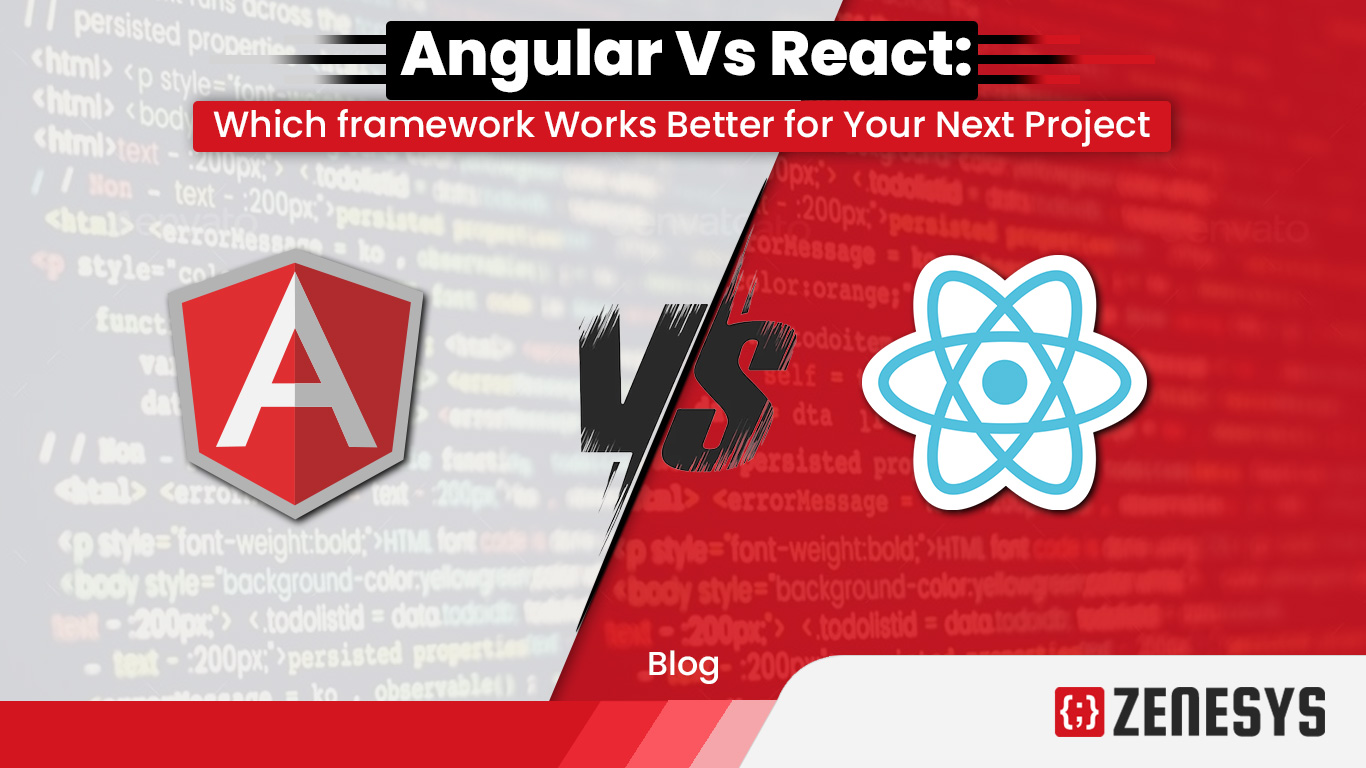React maintains dominant market position with 82% usage rate and 75% developer retention across global projects. Angular holds 50% usage rate with 54% retention, indicating solid but more specialized adoption. GitHub activity reveals React's 222,000+ stars compared to Angular's 86,000+ stars, reflecting community engagement differences.
Web application development can be one of the finest decisions for a business since this aligns with the current trends. As for the data, there are currently 1.9 billion live websites, 4.6 daily Google searches, and over 5.4 billion distinct Internet users.
Read More: An Ultimate Guide For Web Application Development In 2023
Two frameworks that have been massively popular lately amongst developers are Angular and React. Although React developers prefer unidirectional data flow, Angular developers prefer two-way data binding.
Enterprise adoption patterns show distinct preferences. Angular dominates in large-scale business applications requiring structured architecture. React excels in dynamic, interactive applications where development speed matters most. Financial services, healthcare, and manufacturing sectors show stronger Angular preference due to compliance and security requirements.
Deep dive into the article and discover the main distinctions between the two technologies as you continue reading to decide which is best for your project.
Angular & React: The Fundamental Differences
React 19 (released December 2024) brings Server Components, Actions API, and new hooks including useActionState and useOptimistic. These features improve server-side rendering capabilities and asynchronous state management. Concurrent features enhance UI responsiveness under heavy rendering loads.
If we compare the Performance benchmarks comparing Angular 20 and React 19 show React creating 1,000 rows in 29.4ms versus Angular's 34.2ms. However, Angular achieves faster first paint times at 156.1ms compared to React's 211.2ms. Bundle sizes favor Angular with smaller compressed files, while memory usage remains comparable between frameworks.
And all we know web application development is not a easy process. A lot of effort needs to be given to building a good app. Be it Angular or React, both need hard work. Though nowadays, it’s easy to hire react native app developer or an Angular app development company and get rid of these complexities.
| Angular | React | |
| What it is | A complete JavaScript framework based on TypeScript is called Angular (a superset of JavaScript). By adopting components and keeping the dependency injection (DI) and two-way data binding capabilities that Angular developers had grown to appreciate, the new Angular was created to compete with React. |
Facebook initiated the making of an open-source system, which is known as React. Organisations use this framework to develop amazing UI. Using the reusable elements of React, one can develop the whole UI for various software. |
| The initiation | Throughout the ten years span of time, a number of modifications are done. The currently popular framework rolled out in 2009, and brought in modernization in web application development. They improved their platform through a lot of new technology employment like AOT compilation and tree- shaking. After the addition of these with the basic features, the platform had been more admirable to businesses. |
Facebook had a difficult issue in 2011 and had a sizable user base. It aimed to provide consumers with a richer user experience by developing a quicker, more responsive, and more dynamic user interface. It was originally utilized on Facebook's newsfeed. As a result of its revolutionary UI, React basically reinvented Facebook's online development strategy. |
| Componentization | Selector, template, style, and other characteristics that make up the metadata necessary to process a component are scoped to accomplish componentization. | All the HTML and JavaScript required for a UI component are contained in a single JSX file to create components. supports both class-based and stateless (functional) components. |
| Front-end | Extends HTML's capabilities. prefers rendering on the client side. alters the actual DOM. | Uses JSX files, which are JavaScript and HTML hybrids. Favoring server-side rendering a little bit. manipulates a DOM that is not real. |
Performance Analysis and Technical Comparison
DOM Handling Strategies
Angular uses real DOM manipulation with optimized change detection through signals and a zoneless architecture.This approach benefits applications with complex data flows and infrequent updates.
Angular's Ahead-of-Time compilation reduces runtime overhead and improves initial load performance.
React's virtual DOM provides 30-40% faster initial rendering for dynamic interfaces.
The virtual DOM excels in applications requiring frequent UI updates and real-time data synchronization.
React Fiber's priority-based rendering prevents UI blocking during heavy computations.
Bundle Size Comparisons
Framework size analysis reveals significant differences:- Angular 20: 138KB (minified)
- React 19: 98.8KB (minified)
- Vue 3: 53.6KB (minified)
Real-world applications typically add 100-500KB depending on features and dependencies.
React applications often require additional libraries for routing, state management, and form handling, potentially increasing total bundle size.
Runtime Performance Metrics
Memory usage patterns differ between frameworks.Angular applications consume 15-25% more memory during initial load due to dependency injection overhead.
React shows lower baseline memory usage but can accumulate memory in long-running applications without proper cleanup.
CPU utilization favors React for frequent updates and Angular for initial rendering.
Angular's change detection optimizations in version 20 reduce unnecessary re-renders by 60% compared to earlier versions.
Modern Development Practices and Tooling
Build Tools and CLI Capabilities
Angular CLI provides comprehensive project management with schematics for code generation, testing, and deployment.The CLI automates complex configurations and maintains consistent project structure.
Angular 20 introduces smarter defaults and improved error reporting.
React relies on external tools like Vite, Create React App, or Next.js for project setup.
This flexibility allows custom build configurations but requires more initial setup decisions.
The ecosystem offers numerous high-quality options for different use cases.
Testing and Debugging
Angular includes Jasmine and Karma for unit testing with built-in TestBed utilities.The framework's dependency injection simplifies test setup and mocking.
Angular DevTools provides component inspection and performance profiling.
React testing relies on Jest and React Testing Library for component testing.
The ecosystem offers extensive testing utilities but requires library selection and configuration.
React DevTools excels at component debugging and performance analysis.
Server-Side Rendering Advances
Angular 20 introduces incremental hydration reducing initial JavaScript execution by up to 40%.Route-level rendering modes optimize server-side rendering for different page types.
These improvements benefit SEO and initial page load performance.
React 19 Server Components shift rendering logic to the server, reducing client-side JavaScript.
Streaming SSR and selective hydration improve perceived performance.
These features require careful architecture planning but deliver significant benefits.
The Pros & Cons
Angular Pros:
● There is a clean code development option.● Enhanced Effectiveness
● Material Design-Inspired User Interface.
● Due to the routing capabilities of an angular framework.
● It is simple to flip between views.
● Upgrades using Seamless Angular CLI
Angular Cons:
● An angular feature may be confusing to beginners.● There aren't any elaborate instructions or all-encompassing documentation.
● There is a significant learning curve.
● Debugging scopes is tough due to Restricted Routing.
● Angular might lag when pages feature interactive elements.
● Integration with outside parties is quite difficult.
React Pros:
● It is simple to learn due to its uncomplicated design.● You can switch between versions of React.
● An element of Facebook called "codemod" automates a significant portion of the procedure.
● React development skills may be used to boost native development.
React Cons:
● It takes a lot of preparation to integrate Reacts with an ordinary MVC framework like Rail.● A solid grasp of how to combine a user interface with the MVC framework is required for users of ReactJS.
● Businesses often need to hire React native app developers for the advanced and difficult-to-manage UI.
Choose What You NEED
Choose Angular When:
Enterprise Applications: Complex business logic requiring structured architecture and long-term maintenance. Regulatory compliance demands like HIPAA, SOX, or GDPR benefit from Angular's security features.Large Development Teams: Projects with 50+ developers need consistent patterns and integrated tooling. Angular's opinionated structure reduces architectural decisions and maintains code quality.
Long Development Cycles: Multi-year projects requiring stability and predictable upgrade paths. Angular's structured release schedule and enterprise support provide confidence for major investments.
Choose React When:
Dynamic User Interfaces: Applications requiring real-time updates and interactive experiences. Social media platforms, dashboards, and gaming interfaces benefit from React's rendering optimizations.Rapid Development: MVPs and startup projects needing quick iteration cycles. React's learning curve and ecosystem flexibility accelerate initial development.
Cross-Platform Requirements: Projects targeting web and mobile platforms benefit from React Native code sharing. This approach reduces overall development overhead.
Industry-Specific Recommendations
Financial Services: Angular provides regulatory compliance features and structured architecture required for banking and trading applications. Built-in security measures and audit trails support financial regulations.
Healthcare: HIPAA compliance and data security favor Angular's built-in protections. Complex workflow management benefits from structured architecture and dependency injection.
E-commerce: React's performance optimizations improve conversion rates through faster page loads and responsive interactions. SEO capabilities support product discovery and search rankings.
Enterprise SaaS: Angular excels at multi-tenant architectures with role-based access control. Modular design supports feature customization for different customer segments.
Conclusion
Initially, React appears to be easier, and getting started with a React project is quicker. But, React's real benefit of simplicity is negated by the requirement that you get familiar with additional JavaScript frameworks and tools. You may also hire a custom React native app development company.
Gaining expertise in Angular is not fast and easy; rather it's difficult. But on the other hand, it comes with its benefits as well. It is an advanced tool to provide an excellent user experience. It's only one-time labor; once you learn it, that's it.

Lastly, for businesses, it is essential that they look for the right people. You need to hire efficient developers who can solve your problem. After all problem solving is all you are looking for in a business, right? Instead of hiring individuals, you can also hire mobile app developers. If you choose to continue with Angular, then hire Zenesys, an Angular app development company.
.png?lang=en-US&ext=.png)

.webp?lang=en-US&ext=.webp)

.webp?lang=en-US&ext=.webp)

